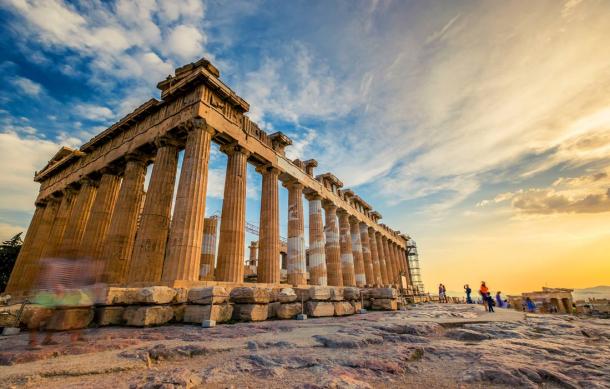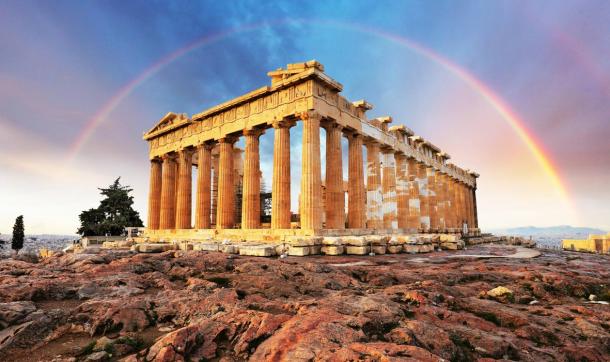The Parthenon, proudly standing on the Athenian Acropolis , is considered by many historians and archaeologists alike as the undisputed symbol of Athenian democracy and the cradle of Western civilization.
The monument is also considered one of the finest buildings of all time by a large number of architects worldwide. It attracts millions of tourists each year and was designed by the most famous sculptor of antiquity, Phidias, while two of the most influential architects ever, Ictinus and Callicrates, supervised the practical construction work of the temple.

The Acropolis, with the Parthenon. ( moofushi /Adobe Stock)
The Mysteries of the Ancient Temple
Contemporary scientists have admitted—despite the Parthenon being the most imitated building in history—that even with modern technology and contemporary architectural techniques, it’s virtually impossible to rebuild the exact same building in all its detail.
But why is the Parthenon so special ? What makes it so different from all the others? What kind of details and secrets did the peoples of antiquity know that have been lost to time? Why can’t we construct an identical building to the original Parthenon even though technology, machinery, and architecture have progressed so much since then? There are too many riddles to the construction of the Parthenon, only a few of which can even remotely begin to be unraveled.
To begin with, the Parthenon might have needed decades to be restored in modern times, but the Athenian citizens mysteriously built it in a decade, between 447 and 438 BC.

The temple was built under Pericles’s rule. Marble bust of Pericles, Roman copy after a Greek original from ca. 430 BC. ( Public Domain )
The iconic monument is a peripteral octastyle Doric temple with Ionic architectural features, surrounded by a colonnade of eight columns across and 17 along, counting the corner columns twice.
The main entrance of the temple faces east while the interior length is 100 Attic feet, thus 30.80 meters (101 feet). And though these numbers might seem random to most, the fact is many historians believe significant proportions are expressed in these numbers.

Low angle perspective of columns of the Parthenon at sunset, Acropolis, Athens. ( Alex Green /Adobe Stock)
Messages in Measurements
An Attic foot is equivalent to 0.30803 meters, or 1/2F (φ), where F (φ) = 1.61803, also known as the Golden Ratio . The Golden Number F, the number 1.618, is often found in nature, in human facial features, in the measurements of the human body, in flowers and other plants, in art, in most living organisms on earth, in shells, and in beehives, among many other things, but most important, it’s often associated with the structure of the universe and planetary orbit in our solar system.
Furthermore, in aesthetic science the Golden Ratio is considered the most accurate standard for the expression of perfection. So, could all this just be a mere coincidence? Not likely, since inside the Parthenon we find something more impressive—the Fibonacci Sequence , which in mathematics describes the phenomenon of a number being equal to the sum of the previous two: 1, 1, 2, 3, 5, 8, 13, 21, 34, 55, 89, 144, etc. Even more strange, the ratio of the successive pairs tends to the so-called Golden Ratio, or Number F (φ).

The Golden Ratio. ( CC BY-SA 2.0 )
Additionally, the number for Pi (π), 3.1416 can also be found inside the temple, which appears in the mathematical relation 2F2/10, but more impressively, we see the number e = 2.72, which is the most important mathematical constant and is the base of the natural logarithm.
What makes things more complicated is that the three numbers included in the Parthenon are also included in all of nature and are present in all creation, and nothing can function without them.
Mathematical Mysteries
As one would expect, the questions deriving from the aforementioned facts are many. Did the creators of the Parthenon know these numbers and their importance? And if so, how did they manage to include them in such detail and accuracy in a building which we can’t replicate today even with all our technology and know-how?
How could the ancient Greeks, or more precisely, Ictinus, Callicrates, and Phidias, be aware of the Golden Ratio when Midhat J. Gazalé and so many other scholars assure us that it was not until Euclid came along that the Golden Ratio’s mathematical properties were studied?

Phidias Showing the Frieze of the Parthenon to his Friends. ( Public Domain )
How did they know of the Fibonacci Sequence when it was first officially recorded in 1202, almost 1,700 years after the Parthenon was constructed? And most importantly, how could the Parthenon’s façade , as well as many of its particular elements, be circumscribed by golden rectangles when the computer technology we take for granted today didn’t exist back then to create such forms?
To all these questions many more can be added as one searches to discover the specific details of the functions and mysteries of the sacred temple; such as, how was the building lit when there were no windows and, even more oddly, no traces of soot have been found, which excludes the use of torches?
Signals in the Sunlight
Another mystery that many experts in various fields have unsuccessfully tried to answer is why, during the day when there is sunlight, do the drop shadows created around the temple always appear to point to other specific destination points in Greece? Which exact points they show and why this happens, or if there’s any special meaning behind this occurrence, has been investigated by scientists for ages, but opinions vary greatly, preventing us from reaching a solution.
Despite all the scientific, paranormal and mythical mysteries surrounding its legend, the Parthenon remains the cradle of Western civilization—and undoubtedly one of the most significant monuments of humankind as a whole.
And it continues to attract millions of curious visitors every year. The only sure thing is that we can only learn and benefit from the iconic monument, its unlocked codes and artistic features, which hopefully will be deciphered in the near future.

The Parthenon is a hugely impressive monument. ( TTstudio /Adobe Stock)
Bonus Facts About the Parthenon
- The Parthenon is often called sacred because it was dedicated to the goddess Athena, whom the people of Athens considered their patron and guardian of the city.
- The temple was built under Pericles’s rule, who is considered to be the greatest Athenian statesman ever and the one who gets credited with the birth of democracy as well.
- The most impressive and glorious part of the Parthenon unfortunately doesn’t exist anymore. It was a gigantic statue of Athena designed and sculpted by Phidias. It was created with elephant ivory and gold and, of course, was dedicated to her.
- Phidias was also the craftsman who sculpted the statue of Zeus at Olympia , which was one of the Seven Wonders of the ancient world.
- The Parthenon is considered to be the most copied building in history. Some of the most famous buildings that have been based on it include The New York Stock Exchange, the Reichstag building in Berlin, and the main entrance of the White House.

Reconstruction of the Acropolis and Areus Pagus in Athens, Leo von Klenze, 1846. ( Public Domain )
Top Image: The majestic and mysterious Parthenon in Athens, Greece. Source: sea and sun /Adobe Stock
By Theodoros II
Updated on January 13, 2021.
Related posts:
Views: 0
 RSS Feed
RSS Feed

















 January 14th, 2021
January 14th, 2021  Awake Goy
Awake Goy  Posted in
Posted in  Tags:
Tags: 
















